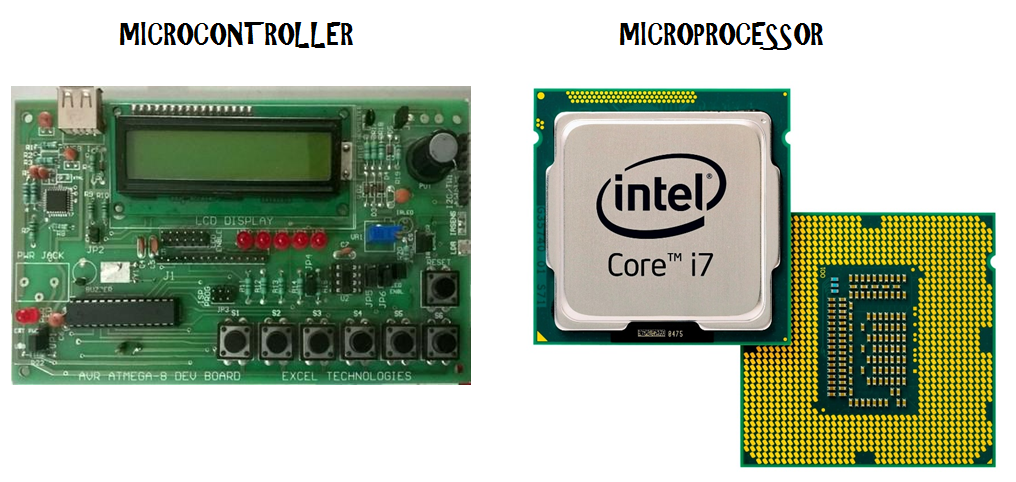Home »
Embedded Systems
Difference Between Microprocessors and Microcontrollers
Microcontrollers Vs. Microprocessors: In this tutorial, we will learn about the differences between a microprocessor and a microcontroller, their main features, advantages, and disadvantages in real applications.
By Sudarshan Paul Last updated : May 12, 2023
The terms microcontroller and microprocessor are commonly misinterpreted to be the same thing even though they have wide areas of difference. The devices have real-time application in many fields. It is true that they share quite a number of similarities between them but the major differences can never be neglected. Apart from field experts, it is impossible for us to distinguish them just by their physical structure.

What are Microprocessors?
Microprocessors are integrated chips that contain only the CPU inside them i.e. they perform only processing-related operations and depend on other chips and systems for full functioning. You must have heard of Intel Pentium, Celeron, i3, and i5 all these are microprocessors with only the processing unit. These ICs lack RAM, ROM, and other required peripherals or devices. So in order to obtain a complete system that can take input and generate output, these microprocessors must be coupled with other peripherals.
These microprocessors find their uses in Desktops and Laptops. Microprocessors are incorporated in systems that need to perform a wide range of tasks such as software development, graphics editing, browsing, etc. Thus the type of input and the type of output required is not specified. Hence they require a high amount of RAM, ROM, and I/O ports for proper functioning.
Advantages of Microprocessors
The same microprocessor board can be utilized for different projects just by changing the peripherals required. Thus saving time and cost of interfacing the peripherals with the board.
Disadvantages of Microprocessor
- The size of the board is large compared to microcontroller since there is a large number of discrete components.
- It requires different peripherals for different projects thus datasheet every component needs to be studied.
What are Microcontrollers?
The microcontrollers have a designated CPU, RAM, ROM, and other peripherals required for normal functioning all integrated within the chip, unlike microprocessors where extra peripherals are added externally. They have inbuilt input–output mechanism. Unlike microprocessors, these are used for performing only specific operations, thus they require a limited amount of resources such as RAM, ROM, and I/O ports.
The microcontrollers require low oscillatory frequency because they are required to be energy efficient and cost-effective. The acting processing speed of microcontrollers is measured in MHz which ranges from 30-50 MHz whereas microprocessors' speed is calculated in GHz ( gigahertz), for a typical desktop computer nowadays it is 3.22GHz.
Microcontrollers are used in small-scale devices which perform only specific operations, they obviously are far cheaper than microprocessors.
Advantages of Microcontrollers
The cost of the microcontroller is far cheaper than microprocessor even for low power frequency. This makes them perfect for programming for low scale projects and devices. They are extremely portable thus helping in their easy mass production.
Disadvantages of Microcontroller
Since all the components are present onboard, therefore, there is no scope for performance improvement by upgrading the components.
Difference Between Microprocessors and Microcontrollers
The following are the 10 key differences between microprocessors and microcontrollers:
| S.No. |
Microprocessors |
Microcontrollers |
| 1 |
Microprocessors are mostly utilized in designing general purpose systems from small to large and complex systems like super computers. |
Microcontrollers are utilized in automatically controlled devices. |
| 2 |
Microprocessor has very high computational capacity. Hence it can execute difficult tasks. |
Microcontrollers have less computational capacity as compared to microprocessors. These are utilized for simpler tasks. |
| 3 |
A microprocessor based system can do numerous tasks. |
A microcontroller based system can do single or very few tasks. |
| 4 |
Microprocessors have ability to do mathematical calculation as they have integrated Math. |
Microcontrollers do not have math coprocessors, so these cannot carry out mathematical calculations |
| 5 |
Microprocessor's Clock Frequency is very high, usually in terms of GHz. |
Clock frequency of Microcontrollers is less usually in terms of MHz. |
| 6 |
Ordinarily microprocessors are not utilized in real time systems as they are severely dependent on several other components. |
Microcontrollers are utilized to handle real time tasks as they are single programmed, self-sufficient and task oriented devices. |
| 7 |
Instruction throughput is prioritized than interrupt latency. |
In contrast, microcontrollers are specially designed to optimize interrupt latency. |
| 8 |
Microcontrollers have a very few bit manipulation instructions. |
Bit manipulation is great and broadly used feature in microcontrollers. They have many bit manipulation instructions. |
| 9 |
Microcontrollers cannot be utilized in dense systems and hence inefficient. |
Can be used in dense systems and hence it is an efficient technique. |
| 10 |
Microprocessors carry out most of the memory based operations as these have less number of registers. |
Program writing in microcontrollers are facilitated due to number of registers. |